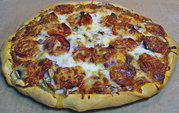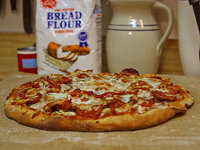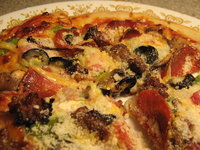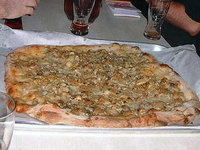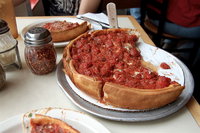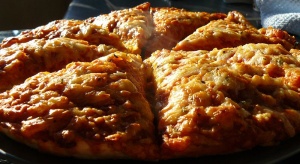Pizza
Pizza (ˈpiːtsə), in Italian: ['pit.tsa] - from the Latin verb pìnsere, to press) is a world-popular dish of Italian origin, made with an oven-baked, flat, generally round bread that is often covered with tomatoes or a tomato-based sauce and mozzarella cheese. Other toppings are added according to region, culture, or personal preference.
Originating as a part of Italian cuisine, the dish has become popular in many different parts of the world. A shop or restaurant where pizzas are made and sold is called a “pizzeria”. The phrases “pizza parlor,” "pizza place" and "pizza shop" are used in the United States. The term pizza pie is dialectal, and pie is used for simplicity in some contexts, such as among pizzeria staff.
History
Main article History of pizza
Base and baking methods
The bottom base of the pizza (called the “crust” in the United States and Canada) may vary widely according to style thin as in hand-tossed pizza or Roman pizza, thick as in pan pizza or Chicago-style pizza. It is traditionally plain, but may also be seasoned with butter, garlic, or herbs, or stuffed with cheese.
In restaurants, pizza can be baked in an oven with stone bricks above the heat source, an electric deck oven, a conveyor belt oven or, in the case of more expensive restaurants, a wood- or coal-fired brick oven. On deck ovens, the pizza can be slid into the oven on a long paddle called a peel and baked directly on the hot bricks or baked on a screen (a round metal grate, typically aluminum). When making pizza at home, it can be baked on a pizza stone in a regular oven to imitate the effect of a brick oven. Another option is grilled pizza, in which the crust is baked directly on a barbecue grill. Greek pizza, like Chicago-style pizza, is baked in a pan rather than directly on the bricks of the pizza oven.
Pizza types
Neapolitan pizza (pizza napoletana): Authentic Neapolitan pizzas are made with local ingredients like San Marzano tomatoes, which grow on the volcanic plains to the south of Mount Vesuvius, and Mozzarella di Bufala Campana, made with the milk from water buffalo raised in the marshlands of Campania and Lazio in a semi-wild state (this mozzarella is protected with its own European protected designation of origin). According to the rules proposed by the Associazione vera pizza napoletana, the genuine Neapolitan pizza dough consists of Italian wheat flour (type 0 or 00, or a mixture of both), natural Neapolitan yeast or brewer’s yeast, salt and water. For proper results, strong flour with high protein content (as used for bread-making rather than cakes) must be used. The dough must be kneaded by hand or with a low-speed mixer. After the rising process, the dough must be formed by hand without the help of a rolling pin or other mechanical device, and may be no more than 3 mm (¹⁄₈ in) thick. The pizza must be baked for 60–90 seconds in a 485C stone oven with an oak-wood fire. When cooked, it should be crispy, tender and fragrant. Neapolitan pizza has been given the status of a “guaranteed traditional specialty” in Italy. This allows only three official variants: pizza marinara, which is made with tomato, garlic, oregano and extra virgin olive oil (although most Neapolitan pizzerias also add basil to the marinara), pizza Margherita, made with tomato, sliced mozzarella, basil and extra-virgin olive oil, and pizza Margherita extra made with tomato, buffalo mozzarella from Campania in fillets, basil and extra virgin olive oil.
Lazio style: Pizza in Lazio (Rome), as well as in many other parts of Italy is available in two different styles: (1) Take-away shops sell pizza rustica or pizza al taglio. This pizza is cooked in long, rectangular baking pans and relatively thick (1–2 cm). The crust is similar to that of an English muffin, and the pizza is often cooked in an electric oven. It is usually cut with scissors or a knife and sold by weight. (2) In pizza restaurants (pizzerias), pizza is served in a dish in its traditional round shape. It has a thin, crisp base quite different to the thicker and softer Neapolitan style base. It is usually cooked in a wood-fired oven, giving the pizza its unique flavor and texture. In Rome, a pizza napoletana is topped with tomato, mozzarella, anchovies and oil (thus, what in Naples is called pizza romana, in Rome is called pizza napoletana).
Other types of Lazio-style pizza include:
- Pizza romana (in Naples): tomato, mozzarella, anchovies, oregano, oil;
- Pizza viennese: tomato, mozzarella, German sausage, oregano, oil;
- Pizza capricciosa (“capricious pizza”): mozzarella, tomato, mushrooms, artichokes, cooked ham, olives, oil (in Rome, prosciutto raw ham is used and half a hard-boiled egg is added);
- Pizza quattro stagioni (“four seasons pizza”): same ingredients for the capricciosa, but ingredients not mixed;
- Pizza quattro formaggi (“four cheese pizza”): tomatoes, mozzarella, stracchino, fontina, gorgonzola (sometimes ricotta can be swapped for one of the last three);
Sicilian-style pizza has its toppings baked directly into the crust. An authentic recipe uses neither cheese nor anchovies. “Sicilian” pizza in the United States is typically a different variety of product made with a thick crust characterized by a rectangular shape and topped with tomato sauce and cheese (and optional toppings). Pizza Hut’s “Sicilian Pizza”, introduced in 1994, is not an authentic example of the style as only garlic, basil, and oregano are mixed into the crust;
White pizza (pizza bianca) uses no tomato sauce, often substituting pesto or dairy products such as sour cream. Most commonly, especially on the east coast of the United States, the toppings consist only of mozzarella and ricotta cheese drizzled with olive oil and spices like fresh basil and garlic. In Rome, the term pizza bianca refers to a type of bread topped with olive oil, salt and, occasionally, rosemary leaves. It’s also a Roman style to top the white pizza with figs, the result called pizza e fichi (pizza with figs);
Ripieno or calzone is a pizza in the form of a half moon, sometimes filled with ricotta, salami and mozzarella; it can be either fried or oven baked.
Non-Italian types of pizza
In the 20th century and onward, pizza has become an international food and the toppings may vary considerably in accordance with local tastes. These pizzas consist of the same basic design but include an exceptionally diverse choice of ingredients.
United States styles and specialties
Due to the wide influence of Italian and Greek immigrants in American culture, the United States has developed quite a large number of regional forms of pizza, many bearing only a casual resemblance to the Italian original. During the latter half of the 20th century, pizza in the United States became an iconic dish of considerable popularity. The thickness of the crust depends on what the consumer prefers; both thick and thin crust are popular. Often, "Americanized" foods such as barbecued chicken and bacon cheeseburgers are used to create new types of pizza. Mexican pizza, or taco pizza, is also popular in the U.S., popularized by the Taco Bell chain.
Ingredients
American pizza often has vegetable oil or shortening (often, but not always, olive oil) mixed into the dough; this is not as common in Italian recipes (for example, the pizza dough recipe in the influential Italian cookbook Il cucchiaio d'argento does not use oil). This can range from a small amount in relatively lean doughs, such as New York style, to a very large amount in some recipes for Chicago-style deep-dish dough. In addition, American pizza (at least thin-crust) is often made with a very high-gluten flour (often 13–14% protein content) of the type also used to make bagels; this type of flour allows the dough to be stretched rather thinly without tearing, similar to strudel or phyllo dough.
Various toppings may be added, most typically:
- Tomato sauce usually replaces the tomato mixture used on Italian-style pizzas, and is usually a fairly heavily seasoned, smooth sauce with a low water content. On some variants without tomatoes, pesto, alfredo and barbecue sauce are also used.
- Cheese, usually mozzarella but also provolone, cheddar, parmesan, feta, or a blend of other cheeses.
- Fruits and vegetables such as garlic, artichoke hearts, eggplant, olives, capers, onions, spinach, tomatoes, bell peppers, green chili peppers, jalapeños, banana peppers and pineapple.
- Fungi, usually Mushrooms and rarely truffles.
- Meat, such as sausage (pepperoni, salami or Italian sausage), ham, bacon, ground beef, and chicken.
- Seafood such as anchovies, tuna, salmon and shrimp.
- Herbs and spices such as basil, oregano and black pepper.
- Nuts such as cashews, pistachios and pine nuts.
- Oils such as olive oil, walnut oil and truffle oil.
In some pizza recipes the tomato sauce is omitted (termed “white pizza”), or replaced with another sauce (usually garlic butter, but sauces can also be made with spinach or onions). In the Philadelphia area there are also tomato pies—sauce only, or sauce with ripe Roma tomatoes and spices but no cheese—and upside-down pizzas, i.e., the cheese on the bottom and topped with sauce. Pizza is normally eaten hot (typically at lunch or dinner), but is sometimes eaten as cold leftovers for breakfast.
Variations
New York-style pizza is a style originally developed in New York City by immigrants from Naples, where pizza was created. It is often sold in generously sized, thin and flexible slices. It is traditionally hand-tossed, moderate on sauce, and moderately covered with cheese essentially amounting to a much larger version of the Neapolitan style. The slices are sometimes eaten folded in half, or even stacked, as its size and flexibility may otherwise make it unwieldy to eat by hand. This style of pizza tends to dominate the Northeastern states, and is very similar to the basic style common through the United States and known simply as pizza. Many pizza establishments in the New York metropolitan area offer two varieties of pizza: “Neapolitan”, or “regular”, made with a relatively thin, circular crust and served in wedge-shaped slices, and “Sicilian”, or “square”, made with a thicker, rectangular crust and served in large, rectangular slices. Another type of pizza, more popular on Long Island but can be found, albeit rarely, in Queens and Manhattan is Grandma pizza. It is cooked in a square pan like Sicilian, but it is much thinner. It has a thin, crispy crust, usually has tomato chunks in addition, or in exception, to the sauce. Generally, it will contain less cheese than regular slices, and sometimes has extra spices or oils baked into the crust.
New Haven-style pizza, also known as apizza, popular in southern Connecticut. It has a thin crust that varies between chewy and tender, depending on the particular establishment. The default version is a “white” pizza topped with only garlic and hard cheeses; customers who want tomato sauce or mozzarella cheese have to ask for them explicitly. Apizza has a very dark, “scorched” crisp crust that offers a distinctive bitter flavor, which can be offset by the sweetness of tomatoes or other toppings.
Greek pizza is a variation popular in New England; its name comes from it being typical of the style of pizzerias owned by Greek immigrants. It has a thicker, chewier crust and is baked in a pan in the pizza oven, instead of directly on the bricks. Plain olive oil is a common part of the topping, as well as being liberally used to grease the pans and crisp the crust. Variations in other parts of the country include using feta cheese, Kalamata olives, and Greek herbs such as oregano.
Chicago-style pizza, or Chicago-style deep-dish pizza, contains a crust which is formed up the sides of a deep-dish pan. It reverses the order of some ingredients, using crust, cheese, filling, then sauce on top. Some versions (usually referred to as stuffed) have two layers of crust with the sauce on top. The invention of deep-dish pizza occurred in America and transcends a single ethnic origin. Deep-dish pizza was invented by Ike Sewell and Ric Riccardo and first served in 1943 at Pizzeria Uno, which is still operating along with its twin restaurant, Pizzeria Due, in the River North neighborhood.
Chicago-style thin-crust pizza has a thinner crust than Chicago-style deep dish, and is baked flat rather than in a deep dish pan. The crust is thin and firm enough to have a noticeable crunch, unlike a New York-style pizza, yet thick enough to be soft and doughy on the top. The crust is invariably topped with a liberal quantity of southern-Italian style tomato sauce, which is usually quite herbal or highly spiced, and typically contains no visible chunks of tomato. Next, a layer of toppings is added, and a layer of mozzarella cheese which frequently separates from the bottom crust due to the quantity of tomato sauce. Chicago-style thin crust pizzas are cut into three-to-four-inch (8–10 cm) squares, also known as “party cut”, as opposed to a “pie cut” into wedges. The small size of the squares makes it unnecessary to fold the slices. Chicago-style pizza is prevalent throughout the Midwestern US. In fact, most of the neighborhood pizza parlors in Chicago and the rest of the Midwest serve Chicago-style thin crust, not deep dish as is commonly assumed. Chains that are well known for Chicago-style thin-crust pizza are Aurelio's Pizza, Home Run Inn and Rosati's Pizza.
St. Louis-style pizza is a thin crust variant that is popular in and around St. Louis, Missouri. The most notable characteristic of St. Louis-style pizza is the distinctively St. Louisan Provel cheese used instead of (or rarely in addition to) the mozzarella common to Chicago-style thin crust. The toppings usually consist of fresh, never frozen, ingredients sliced instead of diced. It is common for the pizza to be topped with large pieces of onion, round slices of bell pepper, and full strips of bacon. If ordered with sausage or hamburger, the meat is squeezed off by hand into marble-sized chunks. The crust is thin enough that it becomes very crunchy in the oven and is sometimes compared to a cracker. Even though the crust is round, it is always cut into small squares.
California-style pizza refers to pizza with non-traditional ingredients, especially those that use a considerable amount of fresh produce. A Thai-inspired chicken pizza with peanut sauce, bean sprouts, and shaved carrots is a popular variant in California-style pizza restaurants, as are pizzas that use chicken and barbecue sauce as toppings. The style was invented by Chez Panisse restaurant in Berkeley, California, and popularized by the California Pizza Kitchen chain, along with Wolfgang Puck’s various fine dining and casual restaurant chains and retail products.
Hawaiian pizza has “Canadian bacon” (or sliced ham) and pineapple toppings with Mozzarella cheese. This type of pizza is especially popular in the western United States, and is also a popular topping combination in Australia, Canada, and Sweden, but notably not in Hawaii. This type is also common within the EU, where it is known as pizza Hawaii.
Taco pizza has ingredients usually associated with tacos, such as; lettuce, shredded beef or hamburger, chopped tomatoes, avocados, corn chips, cheddar cheese, sour cream and taco sauce.
Grilled pizza, invented in Providence, Rhode Island, uses a fairly thin crust cooked on a grill; the toppings are placed on the baked side after the pizza has cooked for a bit and been flipped over.
English muffin and French bread pizza and pizza bagels are common convenience pizzas made at home in an oven or toaster, usually with a simple topping of tomato sauce, sliced or shredded cheese, and perhaps pepperoni. French bread pizza is sometimes available commercially as a frozen meal.
Pizza in Brazil
Pizza is a very popular dish in Brazil, brought by Italian immigrants to that country. The best pizzerie are found in Sao Paulo, a city that calls itself 'The Pizza Capital of the World', hosting more than 6000 pizza establishments and where more than 1.4 million pizzas are consumed every day. It is said that the first Brazilian pizzas were baked in the Bras district of Sao Paulo in the early part of the 20th century. Until the 1950s, they were only found in the Italian communities. Since then, pizza became increasingly popular with the rest of the population. The most traditional pizzeria are still found in the Italian neighborhoods, such as the Bexiga/Bela Vista. Many say that the Brazilian pizza is the best outside Italy. Typically, pizzas follow the Neapolitan variety, rather than the Roman one, being thicker and more doughy.
Pizza in Australia
Pizza is popular in Australia, where a significant percentage of the population is of Italian descent. The usual Italian varieties are available, but there is also the Australian, or australiana, which has the usual tomato sauce base and mozzarella cheese with bacon and egg (seen as quintessentially Australian breakfast fare). Prawns are also sometimes used on this style of pizza.
In the 1980s Australian pizza shops and restaurants began selling gourmet pizzas, essentially pizzas with upmarket ingredients such as salmon, dill, bocconcini, tiger prawns, and even such outré toppings as kangaroo, emu and crocodile meats. Wood-fired pizzas, cooked in an impressive-looking ceramic oven heated by wood fuel, are also popular.
Pizza in India
Pizza is a fast emerging fast food in Indian urban areas. With the arrival of pizza brands like Pizza Hut, Domino's and Smoking Joe's etc, Pizza has reached to many cities in India. Pizza is becoming extremely popular among youth in India.
Pizza outlets serve pizzas with several Indian based toppings like Tandoori Chicken and inclusion of Cottage Cheese (Known as Paneer in India). Indian pizzas are generally made more spicy as compared to their western counterparts, to suit Indian taste. Along with Indian variations, more conventional pizzas are also eaten.
Frozen and ready-to-bake pizzas
Pizza is also found as a frozen food in grocery stores and supermarkets. Some popular brands of these in the US are Tombstone pizza, DiGiorno's, Red Baron and Home Run Inn. A considerable amount of food technology ingenuity has gone into the creation of palatable frozen pizza. The main challenges include preventing the sauce from combining with the dough and producing a crust that can be frozen and reheated without becoming rigid. Modified corn starch is commonly used as a moisture barrier between the sauce and crust. Traditionally the dough is somewhat pre-baked and other ingredients are also sometimes pre-cooked. More recently, frozen pizzas with completely raw ingredients have also begun to appear, as have those with “self-rising” crusts. Many grocery stores and supermarkets also sell fresh, ready-to-bake pizzas. Recently, nearly all of the frozen pizza makers like Jack's, Tony’s, Red Baron and Totino's, as well as the store brands have switched to a lower quality of pepperoni and sausage made with a combination of pork, beef and the recently added mechanically separated chicken.
Another form of uncooked pizza is available from take and bake pizzerias. This pizza is created fresh using raw ingredients, then sold to customers who take it home and bake it in their own ovens and microwaves. Many supermarkets also offer this service.
Similar dishes
- “Farinata” or “cecina”. A Ligurian (farinata) and Tuscan (cecina) regional dish made from chickpea flour, water, salt and olive oil. Also called Socca in the Provence region of France. Often baked in a brick oven, and typically weighed and sold by the slice.
- The Alsatian Tarte flambée (German: Flammkuchen) is a thin disc of dough covered in crème fraîche, onions, and bacon.
- The Anatolian Lahmacun (Arabic: lahma bi ajeen; Armenian: lahmajoun; also Armenian pizza or Turkish pizza) is a meat-topped dough round. The bread is usually very thin; the layer of meat often includes chopped vegetables.
- The Levantine Manakish (Arabic: ma-ujna'at) and Sfiha (Arabic: lahm bi-`ajĩn; also Arab pizza) are dishes similar to pizza.
- The Provençal Pissaladière is similar to an Italian pizza, with a slightly thicker crust and generally a topping of cooked onions, anchovies, and olives.
- Calzone and stromboli are very similar dishes (calzone is traditionally half-moon-shaped, while a stromboli is tube-shaped) that are often made of pizza dough rolled or folded around a filling.
- Garlic fingers is an Atlantic Canadian dish, similar to a pizza in shape and size, and made with the same type of dough. It is garnished with melted butter, garlic, cheese, and sometimes bacon.
- Pizza is sometimes used as a general word for a savory pie; the Campanian pizza rustica and the Italian American pizzagiena (Easter pie) are examples of this more general sense.Template:Fact
- In Scotland Calsons are sold. Derived from the Old Scots language for trouser or hose IPA [kɑːlsən] a calson is a sandwich sized turnover made from pizza dough and stuffed with ingredients such as haggis, lamb, cheddar cheese, potatoes, onions and corned beef, specifically to suit Scottish taste preferences. Tomatoes are not used. It is eaten during soccer games as a hand warming snack. Pizza eating in Scotland derives from the large Scots-Italian immigrant population, now largely assimilated, that settled in Scotland during the 19th century. (Calsowmis, Calsons: old Scots for hose or trousers [1]. They are a tasty snack produced by Uinfoods. [2]
Italian and European law
In Italy there is a bill before Parliament to safeguard the traditional Italian pizza, specifying permissible ingredients and methods of processing (e.g., excluding frozen pizzas). Only pizzas which followed these guidelines could be called “traditional Italian pizzas”, at least in Italy.
Italy has also requested that the European Union safeguard some traditional Italian pizzas, such as “Margherita” and “marinara”. The European Union enacted a protected designation of origin system in the 1990s.
Health issues
Some pizzas can be very high in salt and fat and concerns have been raised about the negative effect these pizzas can have on people’s health. Pizza Hut has come under criticism for the high salt content of some of their meals which were found to contain more than twice the daily recommended amount of salt for an adult.
However, it should also be noted that commercially made fast food pizza is very different from well made Italian pizza, particularly from a good restaurant which is concerned with using only good ingredients, or even more so in a homemade pizza. The salt and saturated fat content of a homemade pizza is usually far less if using original recipes. Mozzarella cheese is not as fatty as many other cheeses, and should be used judiciously in any event. Feta cheese, which has an even lower saturated fat content, is often used in homemade pizza recipes. There is the added bonus of being able to include other healthy ingredients as well, such as fresh tomatoes, peppers, mushrooms, spinach, courgettes (vegetable marrow or zucchini) and aubergine (eggplant), as just a few examples.
Nutrition researchers in Europe investigating the eating habits of people suffering from cancer of the mouth, oesophagus, throat or colon, made an interesting finding with regard to eating pizza. 3,300 sufferers were questioned regarding their eating habits, and their answers compared to over 5,000 healthy respondents.
Those who ate pizza at least once a week had less chance of developing cancer, they found. Dr Silvano Gallus, of the Mario Negri Institute for Pharmaceutical Research in Milan, who led the research said: "We knew that tomato sauce could offer protection against certain tumors, but we did not expect pizza as a complete meal also to offer such protective powers." Nicola O'Connor, of Cancer Research UK, told BBC News Online: "This study is interesting and the results should probably be looked at in the context of what we already know about the Mediterranean diet and its association with a lower risk of certain types of cancer.
"The secret is probably lycopene, an antioxidant chemical in tomatoes, which is thought to offer some protection against cancer, and which gives the fruit its red color.
"But before people start dialing the local pizza takeaway, they should consider that some pizzas can be high in saturated fat, salt and calories". In contrast to the classic Italian pizza used in the research, most UK pizza takeaway varieties are often loaded with high fat cheeses and fatty meats and yeast, a high intake of which can contribute to obesity, itself a risk factor for cancer. "Our advice is to enjoy selected Italian pizza (ie. healthy pizza) in moderation as part of a balanced diet that includes plenty of vegetables and fruit."
Italian Carlo La Vecchia, a Milan-based epidemiologist said Italian pizza lovers should not see the research as a license to indulge their fondness for pizza food. "There is nothing to indicate that pizza is the only thing responsible for these results." He continued: "Pizza could simply be indicative of a lifestyle and food habits, in other words the Italian version of a Mediterranean diet." A Mediterranean diet is rich in olive oil, fiber, vegetables, fruit, flour and freshly cooked food - including traditional Italian healthy pizza.
Records
- The largest pizza ever made was at the Norwood Pick ’n Pay hypermarket in Johannesburg, South Africa. According to the Guinness Book of Records the pizza was 37.4 meters in diameter and was made using 500 kg of flour, 800 kg of cheese and 900 kg of tomato puree. This was accomplished on December 8, 1990.
- On March 22, 2001, Bernard Jordaan of Butler's Pizza, Cape Town, South Africa, delivered a pizza 11042km from Cape Town to Sydney, Australia, to set the world record for the longest pizza delivery. This record was acknowledged in the Guinness Book of Records.
- In Feltham, London, a new record for the farthest food delivery was achieved by Lucy Clough of Domino’s. A vegetarian supreme pizza was cooked on November 17, 2004 and travelled a distance of 10532mi to its delivery point at 30 Ramsay Street, Melbourne, Australia, on November 19, 2004. The record is in the 2006 version of the Guinness Book of Records.
- The most expensive pizza created was made by the restaurateur Domenico Crolla, who created a pizza which included toppings such as sunblush-tomato sauce, Scottish smoked salmon, medallions of venison, edible gold, lobster marinated in the finest cognac and champagne-soaked caviar. The pizza was sold at auction for charity for £2,150.
- What has been called “the world’s most extravagant pizza” is available at New York’s Nino’s Bellissima restaurant. Topped with six varieties of caviar, chives, fresh lobster and crème fraîche, this 12in pie, called the “Luxury Pizza”, retails at US$1,000.00 (or $125.00 a slice).
